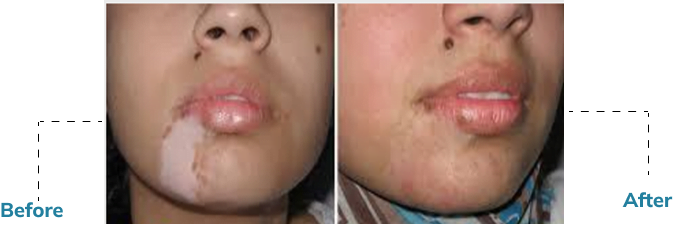Vitiligo

Vitiligo is a condition in which white patches develop on the skin. Any location of the body can be affected. Most people will have white patches on many areas of the body.
The Cause
Melanin pigment is responsible for the skin color. Vitiligo is caused by a loss of melanin pigment in the skin, due to the destruction of pigment-forming cells known as melanocytes. The exact cause of the destruction of these cells is not known. One possible explanation might be that the body’s immune system destroys the cells, as in other autoimmune conditions. Although vitiligo affects all races equally, it is more noticeable in dark-skinned people.
Symptom
- It includes rapid pigment loss on several areas of the skin. The initial appearance of the white patches can be followed by a stable period without any progression of the condition. Later on, further cycles of pigment loss and stability may be observed.
- Vitiligo commonly affects areas on the skin that are exposed to sun, body folds (such as armpits), previous sites of injury, areas around moles and areas around the body openings. It is rare for the pigment to return back once the white patches have developed. Vitiligo can also affect the eyelids and hair.
Treatment
Vitiligo is not just a cosmetic problem. It is a major social dysfunction that seriously curtails their ability to lead a normal social life. Reversal of the white spots and restoration of normal skin color is therefore the primary hope for all the Vitiligo patients.
Several methods, including cosmetics, re-pigmentation using UV light therapy, corticosteroid creams and skin grafting can be used to improve the appearance of skin severely affected by Vitiligo.
Topical Corticosteroid Cream
Initial treatment with certain topical corticosteroid cream is practical, simple, and safe. If there is no response in 2 months, it is unlikely to be effective. Steroid can cause atrophy (thinning) of the skin
Skin Graft
This surgical method is used on larger patches of Vitiligo when other medical treatments are unresponsive. Skin along with healthy melanocytes is grafted to the de-pigmented area. Skin grafting is a very successful technique for scattered vitiligo that has become stable
Melanocyte Transfer
It is one of the most effective treatments for stable Vitiligo. It has an edge over skin grafting because it requires minimal donor site. In this process, healthy melanocytes are transferred into the de-pigmented area, over time these melanocytes will produce pigment which will homogenize and improve pigmentation.
Medical Tattoo
Medical tattoos are a form of restorative micro-pigmentation. It involves using tattoo ink to replenish pigment onto the skin via a tattoo needle and medical tattoo machine. This process is permanent and the ink may fade over time. It is a viable option for unresponsive Vitiligo.
The above mentioned procedures may cause redness, irritation, scarring (keloid), tenderness and bruising. Avoiding sun exposure is advisable and using sun protection of 30+ SPF is recommended. No makeup is to be worn prior-treatment or post-treatment. There may be downtime depending on the surface area of the procedure.
Results
The results of the treatment depend on a lot of factors like hormones, exposure to sun and the age of the patient.

